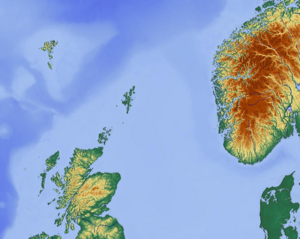Scottish–Norwegian War facts for kids
Quick facts for kids Scottish–Norwegian War |
|||||||||
|---|---|---|---|---|---|---|---|---|---|
|
|||||||||
| Belligerents | |||||||||
| Commanders and leaders | |||||||||
|
|||||||||
| Strength | |||||||||
| Around 12,000 light armed soldiers, around 120 leidang ships | Around 5,000 heavy armed soldiers and 800 heavy cavalry | ||||||||
|
[1]: Magnus III of Orkney did not participate in the war; he remained nominal head of the forces who participated in the war from the Earldom of Orkney. [2]: Haakon IV of Norway died during the war, according to some historians, even though he resided in Orkney, the war was still ongoing. |
|||||||||
The Scottish–Norwegian War was a conflict that took place from 1262 to 1266. It happened because Scotland and Norway disagreed about who owned the Hebrides islands. The war mostly involved small fights and arguments between the kings. The only big battle was the Battle of Largs, which didn't have a clear winner.
Why Did the War Start?
For a long time, the Hebrides and the Isle of Man were under Norway's control. This started way back with King Harald Fairhair of Norway. In 1098, King Magnus III of Norway officially took control. King Edgar, King of Scotland agreed to this. This set the border between Scottish and Norwegian lands in the west.
Norway had taken stronger control over the Hebrides, Orkney, and the Isle of Man. They did this by fighting the local leaders of these islands. The Norwegians called these islands the Suðreyjar, which means Southern Isles.
Scotland had been trying to get the Hebrides back since the 1240s. King Alexander II of Scotland wanted to buy the islands from King Haakon IV of Norway. These talks didn't work for almost ten years. They stopped completely when Alexander II died.
When his son, Alexander III of Scotland, became king in 1262, he tried again. He sent a final message to King Haakon. Alexander III said that if Haakon didn't sell the islands, Scotland would take them by force.
The War Begins (1262–1263)
King Haakon responded to Scotland's threat. He gathered a large fleet of over 120 warships. In July 1263, he sailed to defend the islands. Haakon stopped at the Isle of Arran. There, he started talks with the Scots.
King Haakon knew he needed a big win before winter. But King Alexander III purposely made the talks go slowly. He waited until the autumn storms arrived. In October 1263, a storm hit. Several of Haakon's ships got stuck near Largs.
A group of Norwegian soldiers went ashore to help their ships. Suddenly, Scottish forces attacked them. A small fight happened, but neither side won clearly. The next morning, Haakon's forces sailed back to Orkney for the winter. King Haakon died there in December. His son, King Magnus VI of Norway, took over. Magnus had problems at home and didn't have enough money for another big fight.
How the War Ended
Even though King Haakon died during the war, he was a very important person in starting it. After Haakon's death, King Alexander III of Scotland captured the Hebrides in 1264. Then, Scotland made another official claim to the islands.
The islands were bought from Norway for 4,000 marks. Scotland also agreed to pay 100 marks every year after that. This agreement was part of the Treaty of Perth. In this treaty, Scotland also officially recognized that Norway owned Shetland and Orkney.
See also


